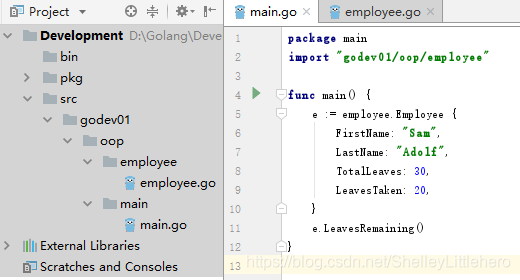Go学习(12):面向对象
面向对象(OOP)
go并不是一个纯面向对象的编程语言。在go中的面向对象,结构体替换了类。
Go并没有提供类class,但是它提供了结构体struct,方法method,可以在结构体上添加。提供了捆绑数据和方法的行为,这些数据和方法与类类似。
1.1 定义结构体和方法
通过以下代码来更好的理解,首先在src目录下创建一个package命名为oop,在oop目录下,再创建一个子目录命名为employee,在该目录下创建一个go文件命名为employee.go。
目录结构:oop -> employee -> employee.go
在employee.go文件中保存以下代码:
package employee
import (
"fmt"
)
type Employee struct {
FirstName string
LastName string
TotalLeaves int
LeavesTaken int
}
func (e Employee) LeavesRemaining() {
fmt.Printf("%s %s has %d leaves remaining", e.FirstName, e.LastName, (e.TotalLeaves - e.LeavesTaken))
}
然后在oop目录下,创建文件并命名为main.go,并保存以下内容
package main
import "oop/employee"
func main() {
e := employee.Employee {
FirstName: "Sam",
LastName: "Adolf",
TotalLeaves: 30,
LeavesTaken: 20,
}
e.LeavesRemaining()
}
运行结果:
Sam Adolf has 10 leaves remaining
或者如下图目录:

1.2 New()函数替代了构造函数
我们上面写的程序看起来不错,但是里面有一个微妙的问题。让我们看看当我们用0值定义employee struct时会发生什么。更改main的内容。转到下面的代码,
package main
import "oop/employee"
func main() {
var e employee.Employee
e.LeavesRemaining()
}
运行结果:
has 0 leaves remaining
通过运行结果可以知道,使用Employee的零值创建的变量是不可用的。它没有有效的名、姓,也没有有效的保留细节。在其他的OOP语言中,比如java,这个问题可以通过使用构造函数来解决。使用参数化构造函数可以创建一个有效的对象。
go不支持构造函数。如果某个类型的零值不可用,则程序员的任务是不导出该类型以防止其他包的访问,并提供一个名为NewT(parameters)的函数,该函数初始化类型T和所需的值。在go中,它是一个命名一个函数的约定,它创建了一个T类型的值给NewT(parameters)。这就像一个构造函数。如果包只定义了一个类型,那么它的一个约定就是将这个函数命名为New(parameters)而不是NewT(parameters)。
更改employee.go的代码:
首先修改employee结构体为非导出(可以理解为java意义上的不公开),并创建一个函数New(),它将创建一个新Employee。代码如下:
package employee
import (
"fmt"
)
type employee struct {
firstName string
lastName string
totalLeaves int
leavesTaken int
}
func New(firstName string, lastName string, totalLeave int, leavesTaken int) employee {
e := employee {firstName, lastName, totalLeave, leavesTaken}
return e
//return employee {firstName, lastName, totalLeave, leavesTaken}
}
func (e employee) LeavesRemaining() {
fmt.Printf("%s %s has %d leaves remaining", e.firstName, e.lastName, (e.totalLeaves - e.leavesTaken))
}
我们在这里做了一些重要的改变。我们已经将Employee struct的起始字母e设置为小写,即我们已经将类型Employee struct更改为type Employee struct。通过这样做,我们成功地导出了employee结构并阻止了其他包的访问。将未导出的结构的所有字段都导出为未导出的方法是很好的做法,除非有特定的需要导出它们。由于我们不需要在包之外的任何地方使用employee struct的字段,所以我们也没有导出所有字段。
由于employee是未导出的,所以不可能从其他包中创建类型employee的值。因此,我们提供了一个输出的新函数。将所需的参数作为输入并返回新创建的employee。
这个程序还需要做一些修改,让它能够工作,但是让我们运行这个程序来了解到目前为止变化的效果。如果这个程序运行,它将会失败,有以下编译错误,
go/src/constructor/main.go:6: undefined: employee.Employee
这是因为我们有未导出的Employee,因此编译器抛出错误,该类型在main中没有定义。而这正是我们想要的。现在没有其他的包能够创建一个零值的员工。我们成功地防止了一个无法使用的员工被创建。现在创建员工的唯一方法是使用新函数employee.New(..)。
修改main.go代码
package main
import "oop/employee"
func main() {
e := employee.New("Sam", "Adolf", 30, 20)
e.LeavesRemaining()
}
运行结果:
Sam Adolf has 10 leaves remaining
因此,我们可以明白,虽然Go不支持类,但是结构体可以有效地使用,在使用构造函数的位置,使用New(parameters)的方法即可。
1.3组成(Composition )替代了继承(Inheritance)
Go不支持继承,但它支持组合。组合的一般定义是“放在一起”。构图的一个例子就是汽车。汽车是由轮子、发动机和其他各种部件组成的。
博客文章就是一个完美的组合例子。每个博客都有标题、内容和作者信息。这可以用组合完美地表示出来。
1.3.1 通过嵌入结构体实现组成
可以通过将一个struct类型嵌入到另一个结构中实现。
示例代码:
package main
import (
"fmt"
)
/*
我们创建了一个author struct,它包含字段名、lastName和bio。我们还添加了一个方法fullName(),将作者作为接收者类型,这将返回作者的全名。
*/
type author struct {
firstName string
lastName string
bio string
}
func (a author) fullName() string {
return fmt.Sprintf("%s %s", a.firstName, a.lastName)
}
/*
post struct有字段标题、内容。它还有一个嵌入式匿名字段作者。这个字段表示post struct是由author组成的。现在post struct可以访问作者结构的所有字段和方法。我们还在post struct中添加了details()方法,它打印出作者的标题、内容、全名和bio。
*/
type post struct {
title string
content string
author
}
func (p post) details() {
fmt.Println("Title: ", p.title)
fmt.Println("Content: ", p.content)
fmt.Println("Author: ", p.author.fullName())
fmt.Println("Bio: ", p.author.bio)
}
func main() {
author1 := author{
"Naveen",
"Ramanathan",
"Golang Enthusiast",
}
post1 := post{
"Inheritance in Go",
"Go supports composition instead of inheritance",
author1,
}
post1.details()
}
运行结果:
Title: Inheritance in Go
Content: Go supports composition instead of inheritance
Author: Naveen Ramanathan
Bio: Golang Enthusiast
嵌入结构体的切片
在以上程序的main函数下增加以下代码,并运行
type website struct {
[]post
}
func (w website) contents() {
fmt.Println("Contents of Website\n")
for _, v := range w.posts {
v.details()
fmt.Println()
}
}
运行报错:
main.go:31:9: syntax error: unexpected [, expecting field name or embedded type
这个错误指向structs []post的嵌入部分。原因是不可能匿名嵌入一片。需要一个字段名。我们来修正这个错误,让编译器通过。
type website struct {
posts []post
}
现在让我们修改的main函数,为我们的新的website创建几个posts。修改完完整代码如下:
package main
import (
"fmt"
)
type author struct {
firstName string
lastName string
bio string
}
func (a author) fullName() string {
return fmt.Sprintf("%s %s", a.firstName, a.lastName)
}
type post struct {
title string
content string
author
}
func (p post) details() {
fmt.Println("Title: ", p.title)
fmt.Println("Content: ", p.content)
fmt.Println("Author: ", p.fullName())
fmt.Println("Bio: ", p.bio)
}
type website struct {
posts []post
}
func (w website) contents() {
fmt.Println("Contents of Website\n")
for _, v := range w.posts {
v.details()
fmt.Println()
}
}
func main() {
author1 := author{
"Naveen",
"Ramanathan",
"Golang Enthusiast",
}
post1 := post{
"Inheritance in Go",
"Go supports composition instead of inheritance",
author1,
}
post2 := post{
"Struct instead of Classes in Go",
"Go does not support classes but methods can be added to structs",
author1,
}
post3 := post{
"Concurrency",
"Go is a concurrent language and not a parallel one",
author1,
}
w := website{
posts: []post{post1, post2, post3},
}
w.contents()
}
运行结果:
Contents of Website
Title: Inheritance in Go
Content: Go supports composition instead of inheritance
Author: Naveen Ramanathan
Bio: Golang Enthusiast
Title: Struct instead of Classes in Go
Content: Go does not support classes but methods can be added to structs
Author: Naveen Ramanathan
Bio: Golang Enthusiast
Title: Concurrency
Content: Go is a concurrent language and not a parallel one
Author: Naveen Ramanathan
Bio: Golang Enthusiast
1.4 多态性(Polymorphism)
Go中的多态性是在接口的帮助下实现的。正如我们已经讨论过的,接口可以在Go中隐式地实现。如果类型为接口中声明的所有方法提供了定义,则实现一个接口。让我们看看在接口的帮助下如何实现多态。
任何定义接口所有方法的类型都被称为隐式地实现该接口。
类型接口的变量可以保存实现接口的任何值。接口的这个属性用于实现Go中的多态性。
举个例子,一个虚构的组织有两种项目的收入:固定的账单和时间和材料。组织的净收入是由这些项目的收入之和计算出来的。为了保持本教程的简单,我们假设货币是美元,我们不会处理美分。它将使用整数来表示。
首先我们定义一个接口:Income
type Income interface {
calculate() int
source() string
}
接下来,定义两个结构体:FixedBilling和TimeAndMaterial
type FixedBilling struct {
projectName string
biddedAmount int
}
type TimeAndMaterial struct {
projectName string
noOfHours int
hourlyRate int
}
下一步是定义这些结构体类型的方法,计算并返回实际收入和收入来源。
func (fb FixedBilling) calculate() int {
return fb.biddedAmount
}
func (fb FixedBilling) source() string {
return fb.projectName
}
func (tm TimeAndMaterial) calculate() int {
return tm.noOfHours * tm.hourlyRate
}
func (tm TimeAndMaterial) source() string {
return tm.projectName
}
接下来,我们来声明一下计算和打印总收入的calculateNetIncome函数。
func calculateNetIncome(ic []Income) {
var netincome int = 0
for _, income := range ic {
fmt.Printf("Income From %s = $%d\n", income.source(), income.calculate())
netincome += income.calculate()
}
fmt.Printf("Net income of organisation = $%d", netincome)
}
上面的calculateNetIncome函数接受一部分Income接口作为参数。它通过遍历切片和调用calculate()方法来计算总收入。它还通过调用source()方法来显示收入来源。根据收入接口的具体类型,将调用不同的calculate()和source()方法。因此,我们在calculateNetIncome函数中实现了多态。
在未来,如果组织增加了一种新的收入来源,这个函数仍然可以正确地计算总收入,而没有一行代码更改。
最后我们写以下主函数:
func main() {
project1 := FixedBilling{projectName: "Project 1", biddedAmount: 5000}
project2 := FixedBilling{projectName: "Project 2", biddedAmount: 10000}
project3 := TimeAndMaterial{projectName: "Project 3", noOfHours: 160, hourlyRate: 25}
incomeStreams := []Income{project1, project2, project3}
calculateNetIncome(incomeStreams)
}
运行结果:
Income From Project 1 = $5000
Income From Project 2 = $10000
Income From Project 3 = $4000
Net income of organisation = $19000
假设该组织通过广告找到了新的收入来源。让我们看看如何简单地添加新的收入方式和计算总收入,而不用对calculateNetIncome函数做任何更改。由于多态性,这样是可行的。
首先让我们定义Advertisement类型和calculate()和source()方法。
type Advertisement struct {
adName string
CPC int
noOfClicks int
}
func (a Advertisement) calculate() int {
return a.CPC * a.noOfClicks
}
func (a Advertisement) source() string {
return a.adName
}
广告类型有三个字段adName, CPC(cost per click)和noof点击数(cost per click)。广告的总收入是CPC和noOfClicks的产品。
修改主函数:
func main() {
project1 := FixedBilling{projectName: "Project 1", biddedAmount: 5000}
project2 := FixedBilling{projectName: "Project 2", biddedAmount: 10000}
project3 := TimeAndMaterial{projectName: "Project 3", noOfHours: 160, hourlyRate: 25}
bannerAd := Advertisement{adName: "Banner Ad", CPC: 2, noOfClicks: 500}
popupAd := Advertisement{adName: "Popup Ad", CPC: 5, noOfClicks: 750}
incomeStreams := []Income{project1, project2, project3, bannerAd, popupAd}
calculateNetIncome(incomeStreams)
}
运行结果:
Income From Project 1 = $5000
Income From Project 2 = $10000
Income From Project 3 = $4000
Income From Banner Ad = $1000
Income From Popup Ad = $3750
Net income of organisation = $23750
综上,我们没有对calculateNetIncome函数做任何更改,尽管我们添加了新的收入方式。它只是因为多态性而起作用。由于新的Advertisement类型也实现了Income接口(习惯了java,怎么理解Go中实现接口这个意思?),我们可以将它添加到incomeStreams切片中。calculateNetIncome函数也在没有任何更改的情况下工作,因为它可以调用Advertisement类型的calculate()和source()方法。


 浙公网安备 33010602011771号
浙公网安备 33010602011771号